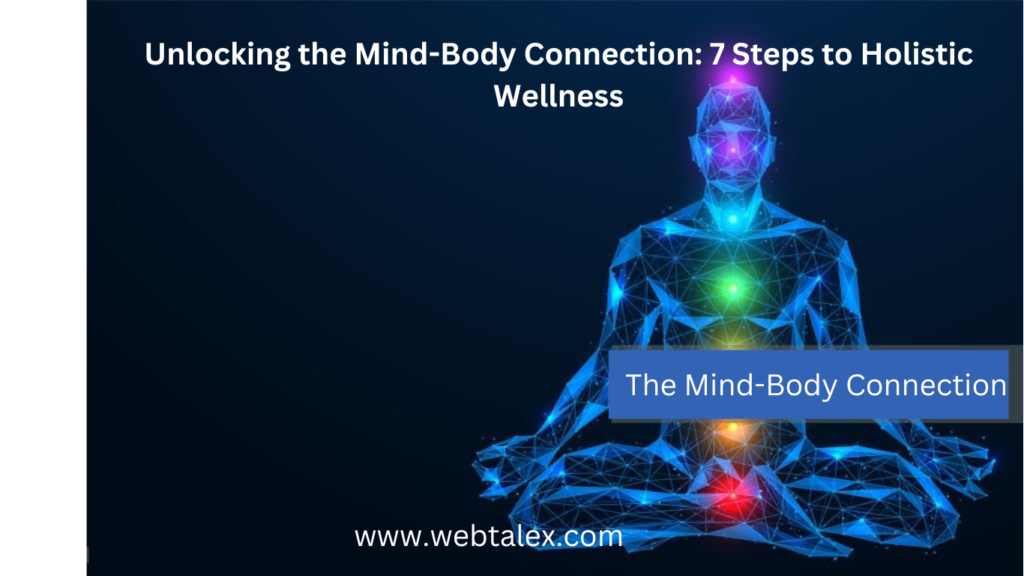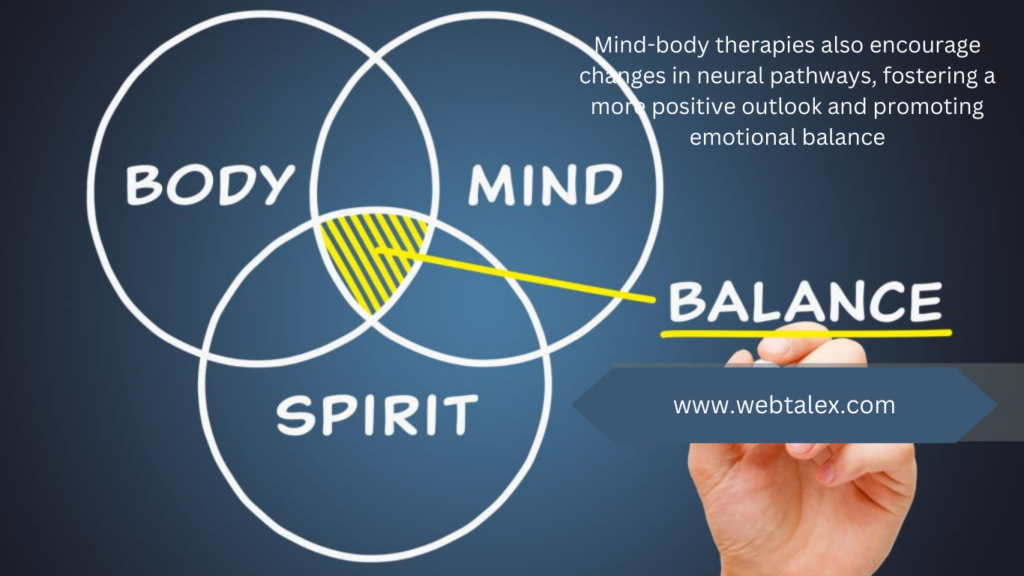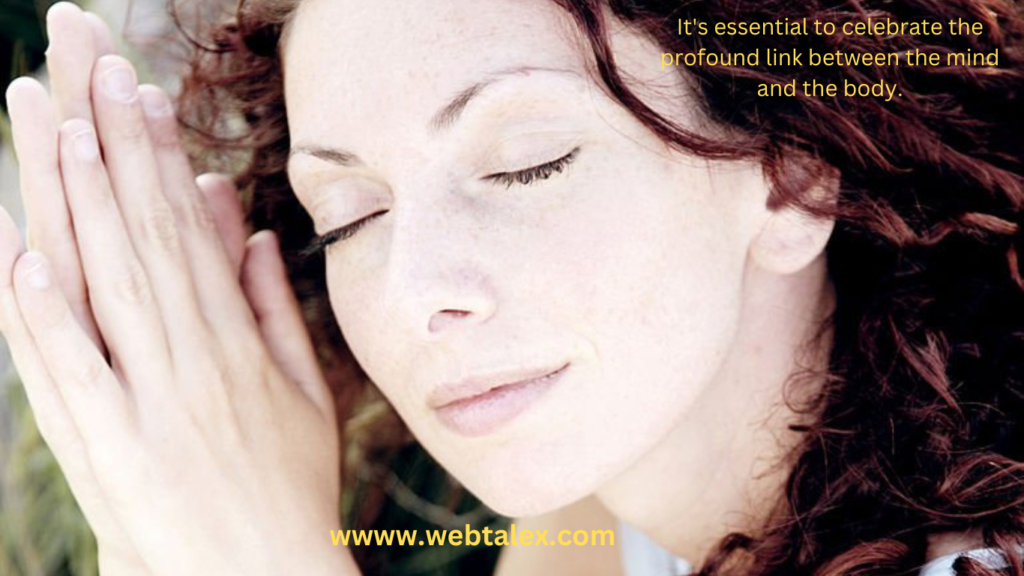“Now Unlocking the Mind-Body Connection: The Best 7 Steps to Holistic Wellness,” this insightful article reveals the key to achieving a balanced and vibrant life through a deeper understanding of the profound link between our mental and physical well-being.
What is the mind-body connection?
The relationship between our internal and physical health is profound and complex, and it’s known as the relationship between the mind and body. It’s a recognition that our studies, feelings, and beliefs can significantly impact our physical health.
This conception has deep roots in colorful ancient mending traditions, including indigenous knowledge, Ayurveda, and traditional Chinese drugs. In substance, it underscores that our internal and emotional countries aren’t separate from our fleshly health but are connected angles of our overall well-being.

Benefits of a Mind-Body Approach
Embracing a mind-body approach to health offers a plethora of benefits
- Stress Reduction: Mind-body ways like contemplation, deep breathing, and awareness help reduce stress by calming the mind and relaxing the body.
- Enhanced Emotional Well-Being: These practices promote emotional adaptability, helping individuals manage anxiety, depression, and other internal health challenges.
- Bettered Physical Health: A harmonious mind-body connection can appreciatively affect physical health, leading to better cardiovascular health, vulnerable function, and pain relief.
- Enhanced tone-mindfulness awareness: practices foster tone-mindfulness, enabling individuals to better understand their studies, feelings, and behavioral patterns.
- Holistic Healing The mind-body approach recognizes that mending involves the whole person, addressing the root causes of affections rather than just their symptoms.

How They Work
Mind-body ways employ the intricate connection between the brain, the central nervous system, and fleshly functions. When individuals engage in practices like contemplation or visualization, it can evoke a relaxation response—a state of deep rest that counters the stress response. This, in turn, reduces the production of stress hormones and promotes physical and internal relaxation.
Also, these practices stimulate the release of salutary neurotransmitters and hormones, such as serotonin and endorphins, which enhance mood and overall well-being. Mind-body therapies also encourage changes in neural pathways, fostering a more positive outlook and promoting emotional balance.
Substantiation
The evidence supporting the relationship between the mind and body is compelling. Scientific studies have shown that mind-body practices can have a profound impact on health
- Stress Reduction: Exploration demonstrates that awareness, contemplation, and relaxation methods reduce stress labels in the body, leading to better internal and physical health.
- Pain Management: Mind-body approaches like yoga and acupuncture have been effective in easing habitual pain conditions.
- Mental Health: Cognitive-behavioral therapy (CBT), a mind-body remedy, is extensively honored as an effective treatment for depression and anxiety diseases.
- Immune System Boost: Studies suggest that practices like contemplation can enhance vulnerable functions, making the body more flexible to ailments.
Choosing a Therapy
Choosing a remedy When choosing a mind-body remedy, it’s essential to consider your specific requirements and preferences:
- Mindfulness Meditation: Ideal for stress reduction and enhancing tone mindfulness.
- Yoga is effective for perfecting inflexibility, strength, and relaxation.
- Tai Chi promotes balance, inflexibility, and emotional well-being.
- Cognitive-behavioral remedy( CBT): suitable for those seeking help managing anxiety or depression.
- Acupuncture: salutary for pain operations and promoting energy balance.
- Biofeedback is a precious tool for learning to control physiological functions, similar to heart rate and muscle pressure.
More Mind-Body Resources
Exploring the relationship between the mind and body further is a journey toward holistic well-being. Consider these additional resources:
- Books: There are numerous perceptive books on mind-body approaches, including” The Relaxation Response” by Herbert Benson and” The Phenomenon of Awareness” by Thich Nhat Hanh.
- Online Courses: multitudinous online courses and apps offer guided contemplation, yoga, and awareness training.
- Original Workshops Look for shops and classes in your community that concentrate on mind-body practices.
- Mind-Body Centers Some healthcare installations have devoted mind-body centers where you can pierce a range of curatives and coffers.
The relationship between the mind and body offers a profound avenue for perfecting your overall health and well-being. By embracing these practices and coffers, you can embark on a journey toward balance, adaptability, and holistic mending.

7 Steps to Holistic Wellness
In our fast-paced lives, where stress and anxiety have become too common, it’s essential to celebrate the profound link between the mind and the body. The relationship between the mind and body isn’t just a philosophical conception; it’s an important tool for achieving holistic heartiness.
By understanding and employing this connection, we can transfigure our lives and nurture our well-being on all fronts. In this composition, we will explore seven practical ways to unleash the relationship between the mind and body and embark on a trip toward holistic heartiness.
Step 1: Embrace Mindfulness Meditation
Awareness and contemplation are the foundations of the relationship between the mind and body. It involves being completely present in the moment, cultivating tone-mindfulness, and observing studies and feelings without judgment.
Regular practice reduces stress, anxiety, and depression while enhancing emotional resilience. Start with just a few minutes each day and gradually extend your practice to experience its full benefits.
Step 2: Nourish Your Body with Healthy Foods
The food we consume has a direct impact on our internal and physical health. conclude a balanced diet rich in fruits, vegetables, whole grains, spare proteins, and healthy fats. These nutrient-thick foods provide essential vitamins and minerals that support brain function and overall vitality, strengthening the relationship between the mind and body
Step 3: Prioritize Regular Exercise
Physical activity is a potent way to enhance the relationship between the mind and body. Exercise releases endorphins, natural mood lifters that reduce stress and boost the passion for well-being. Find an exercise you enjoy, whether it’s walking, jogging, yoga, or dancing, and make it a regular part of your routine.
Step 4: Cultivate Positive Thoughts
Our thoughts have a significant impact on our emotions and physical well-being. Practice positive affirmations and gratitude daily. Challenge negative thought patterns and replace them with constructive ones. A positive mindset fosters a healthier relationship between the mind and body and contributes to overall wellness.
Step 5: Connect with Nature
Spending time in nature has a comforting effect on the mind and body. Whether it’s a walk in the demesne, hiking in the forestland, or simply sitting in your theater, immersing yourself in nature reduces stress and promotes a sense of tranquility. Nature is an important supporter in strengthening the relationship between the mind and body
Step 6: Foster Supportive Relationships
Healthy relationships play a vital role in holistic wellness. Cultivate connections with friends and family who provide emotional support and encouragement. Social interactions positively influence mental health, reinforcing the relationship between the mind and body.
Step 7: Get Adequate Rest and Sleep
Sleep is essential for internal and physical revivification. Aim for seven to eight hours of quality sleep each night. A well-rested body and mind are more equipped to handle stress and maintain a strong relationship between the mind and body.
Unleashing the relationship between the mind and body is an ongoing journey that requires commitment and practice. Incorporating these seven ways into your daily life can lead to profound advancements in your overall well-being. As you embrace awareness, nourish your body, exercise regularly, cultivate positivity, connect with nature, nurture connections, and prioritize rest, you will find yourself on the path to holistic heartiness.
Start your journey today and unlock the transformative potential of this powerful connection.
FAQs
- 1. What’s the mind-body connection?
The relationship between the mind and body refers to the intricate relationship between our internal and physical well-being, where our studies, feelings, and beliefs can significantly impact our physical health.
- 2. Why is awareness contemplation important for the mind-body connection?
Awareness contemplation is pivotal because it cultivates tone-mindfulness, reduces stress, and enhances emotional adaptability, strengthening the link between the mind and body.
- 3. How can I incorporate awareness and contemplation into my diurnal routine?
Start with many twinkles each day and gradually extend your practice. Find a quiet space, concentrate on your breath, and be completely present in the moment.
- 4. What part does diet play in the mind-body connection?
A balanced diet with nutrient-thick foods supports brain function and overall vitality, contributing to a healthier relationship between the mind and body.
- 5. Is exercise essential for the mind-body connection?
Yes, regular exercise releases endorphins, reduces stress, and boosts well-being, making it a crucial element in strengthening the relationship between the mind and body.
- 6. How can I maintain a positive mindset?
Practice positive affirmations and gratitude daily, challenge negative thought patterns, and replace them with constructive ones to foster a positive mindset.
- 7. Why is spending time in nature important for the mind-body connection?
Nature has a comforting effect on the mind and body, reducing stress and promoting a sense of tranquility, therefore enhancing the relationship between the mind and body.

